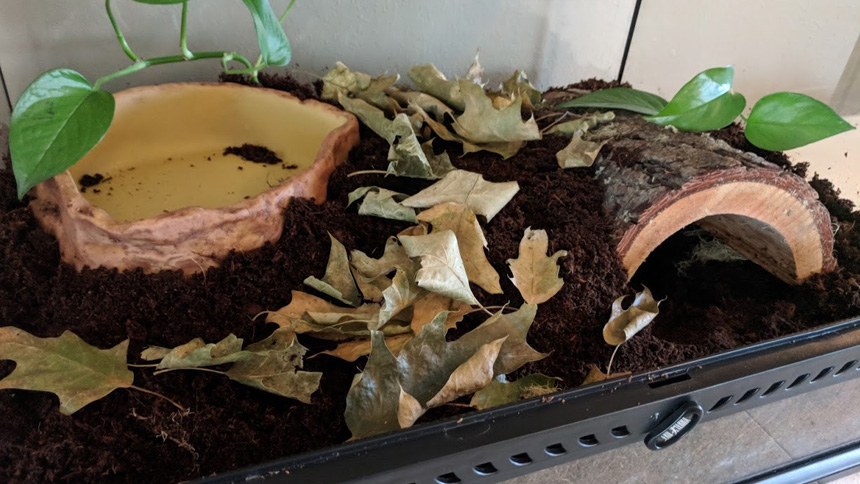
How to Set Up a (Terrestrial) Toad & Frog Habitat
In this guide, I’m going to show you the basics of setting up a terrarium for terrestrial frogs. When I mention ‘terrestrial’ I’m referring to species most suited for walking on land. Most ‘true toads’ (species in the Bufonidae family) fall into this category but there are some frogs suitable for this type of enclosure too.
The types of Anura (frog and toad) going into an enclosure like this are often the types that don’t climb, jump very high, or require as much water as other frogs.
Keep in mind, this is a guide for setting up a basic terrestrial frog enclosure; it’s not meant for one specific kind of frog because each species has its own needs. For example, American toads, Pacman Frogs, or Tomato Frogs would fit nicely into the example below, but if you were creating an enclosure for an Asian horned frog, you might want to alter this build by including a drainage layer and adding more leaf litter.
The point being, use this guide as an example. Read complete care guides to find out more about the species you want to keep as a pet, then alter the enclosure to suit their needs.
Page Contents
Basic Tank Setup for Terrestrial Frogs and Toads
In this build, I used this Exo Terra terrarium, but you can use an ‘aquarium’ or breeder tank. It’s hard to say which is better and what size you need. It all comes down to the species and how many you’re keeping.
As a general rule, most keepers recommend at least 10-gallons per frog. This means, if you want to keep 3 frogs in one enclosure, you’ll need a 30-gallon tank. I tend to agree with this rule. While you can offer a smaller enclosure for small species like Red Belly Toads, something larger is needed for Pixie Frogs. To risk sounding like a broken record, the size depends on the species. Anyway, without further delay, here is how to setup up a cage for terrestrial frogs and toads.
| Image | Description |
|---|---|
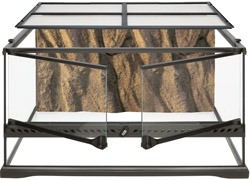 | Exo Terra Terrarium 24x18x18 (large) Great for housing 3 – 4 frogs. It has a front-opening door, vents, and screen lid. |
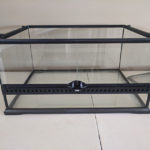 | Exo Terra Outback Terrarium 24x18x12 (large) Great for 3 – 4 frogs. It’s the same as the terrarium listed above except its only 12″ in height. |
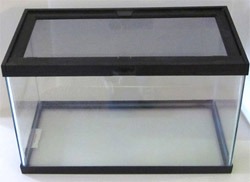 | Zilla Critter Cage (15-gallon) This is a smaller tank you can keep 1 – 2 frogs in. It comes with a screen lid. |
Step 1: Choosing Your Enclosure
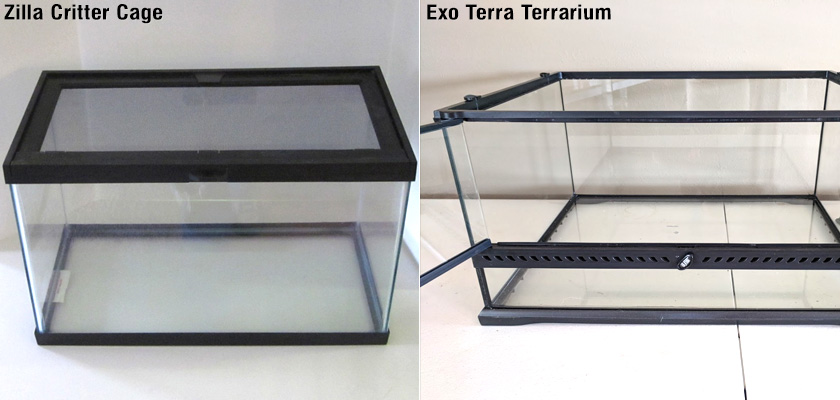
Choosing your cage is the first step. A standard glass tank (often referred to as an ‘aquarium’) is practical and cost-effective. The difference between an aquarium and a terrarium is its contents. A glass tank containing water is called an aquarium while the same glass tank containing substrate, plants & decorations is called a terrarium. Now that we’re on the same page, I’ll show you two really good terrariums for toad cages.
Nice and affordable, the Zilla Critter Cage is a great option. They come in 10-gallon and 15-gallon and they all come with a screen lid. They’re not huge but it’s enough room for at least one moderately sized toad. If this is the one you choose, I suggest the 15-gallon Critter Cage.
If you want to step-it-up a notch, my recommendation is an Exo Terra terrarium. Designed specifically for reptiles and amphibians, these terrariums have front opening doors which give you access to the inside. Below the doors are air vents that allow fresh air circulation. They come with locking screen lids that have special holes designed for running cords or hoses out the top. Most of them come with foam backgrounds which look great and conceal cords and hoses as well. These are my personal favorites; I recommend a 24″ x 18″ x 18″ Exo Terra.
Step 2: Clean The Terrarium
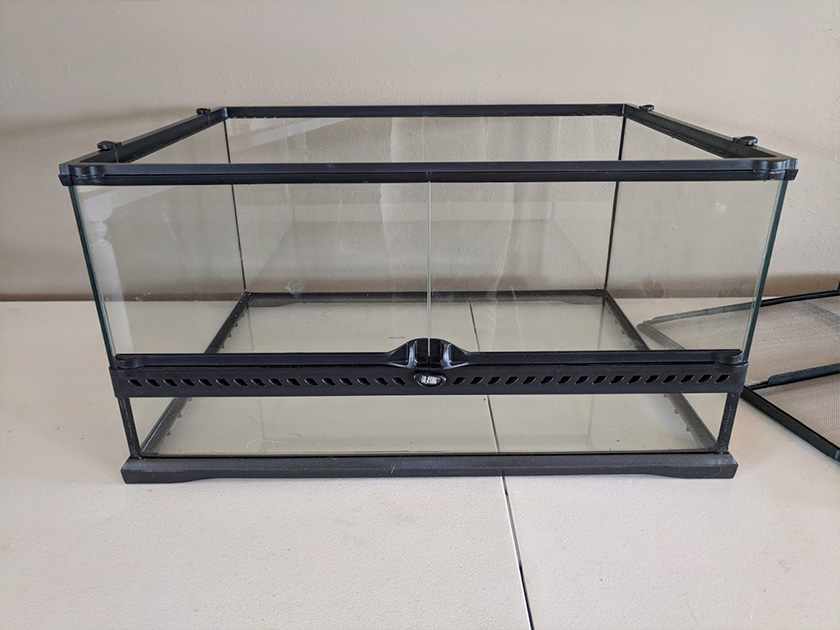
Once you’ve purchased and unwrapped your frog’s new enclosure, it’s a good idea to clean it first. Use distilled water and paper towels. Be careful not to use cleaning products with chemicals, as they can be harmful to amphibians. Our only object is to remove dust that may have accumulated on the glass before you purchased it.
Also, it’s a good idea to place your terrarium where you want to keep it. It will become very heavy after everything else is added.
Step 3: Add the Substrate
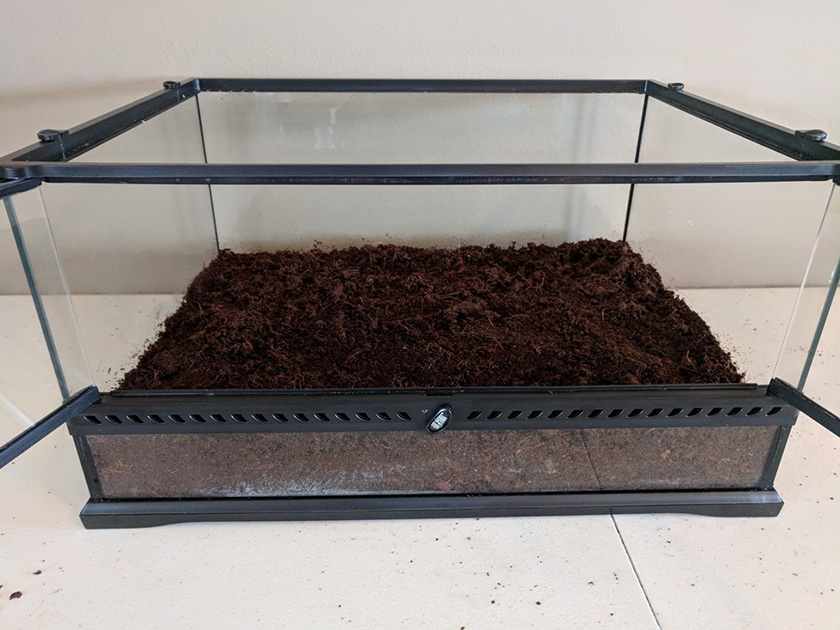
For most setups, the next step is to add the substrate to the terrarium. Things like eco earth and plantation soil, which are coco-husk fiber substrates, are great for most amphibians. Mixtures of soil, vermiculite, and sphagnum moss work well too.
Substrate tips for Toad habitats:
- Use a loose substrate like coco-husk fiber (eco earth, Exo Terra plantation soil)
- Use sturdy decorations so the toad doesn’t knock them over
- Sturdy, living plants should be placed out of the way
- If you use live plants, consider using an ABG mix and adding a grow light
For more information on this topic, see the substrate guide.
Many frogs like to burrow. As such, the substrate should be 2 – 4 inches deep, depending on the size of your pet.
About drainage layers
If the frog you’re keeping requires high humidity, I suggest adding a drainage layer before adding your substrate. When a lot of water is involved, it’s a good idea to ensure water drains properly to keep the substrate from becoming soggy. Again, this does not apply for most setups. If you’re sure you don’t need a drainage layer, you can skip the rest of this step and go to step 4.
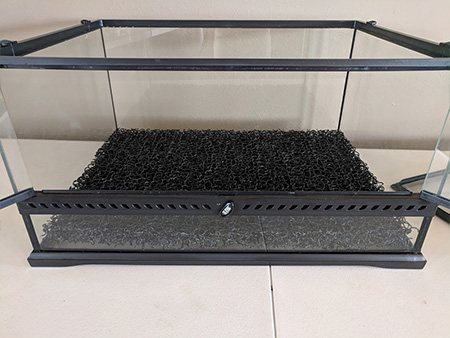
To set up a drainage layer, fill the bottom of the cage with Hydroballs or use a Matala filter. I cannot stress how much more I like using Matala than Hydroballs. I’ve used Hydroballs before and they work great, I just happen to prefer Matala filters.
You have to cut it to fit the size of your terrarium but it’s the best material for supporting your substrate while allowing water to collect underneath it. After adding the bottom layer, the next layer is a substrate barrier; a piece of mesh material which allows water to pass through, but keeps your substrate above the bottom layer.
Once you have your drainage layer and mesh barrier in place, you can add the substrate. Again, needing a drainage layer for a terrestrial species is rare. It’s only a recommendation if the frog you’re keeping requires super high humidity and your substrate is at risk of becoming soggy.
Step 4: Create ‘Hides’
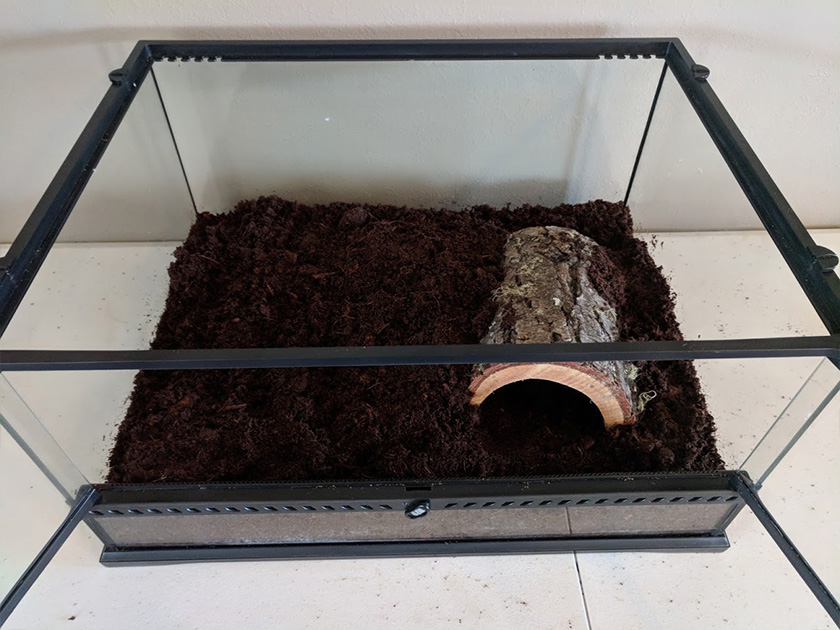
The next step is to create hiding places. This can be accomplished by using hollow logs like the one in the picture above. Cork bark flats and branches are other popular items used for creating hides.
When I set up this terrarium (the one in the pictures), I wasn’t making it for a specific species. In fact, I made this with just a few items I had left over; to give you an example for building your cage. If I were to create an enclosure for a toad, I would make at least 2 hides. One of which would be a ‘humid hide’ using sphagnum moss.
Step 5: Add the Water Dish
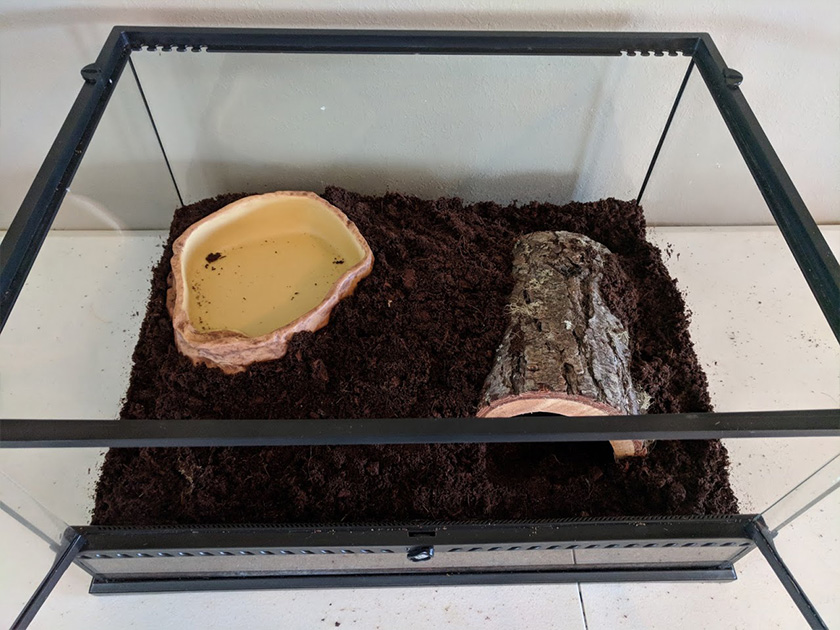
A small or medium water dish is all that’s required in most cases. The one I used was way too big but its all I had at the moment. If you have an x-large water dish, it will work but something smaller is usually better.
The important part is the depth of the water. The main goal is to allow your frog to soak their skin as they see fit; they shouldn’t have to go swimming in order to do this. In short, keep the water shallow, regardless of the size of their water dish.
Most important, a water dish for a large terrestrial toad or frog habitat should be sturdy. It needs to be secure in place; don’t allow simply sit it in the enclosure and move on to the next step. Be sure its firm in position. Add some substrate around it. Purchase (or make) a water dish which is heavy.
Step 6: Add Plants & Decorations
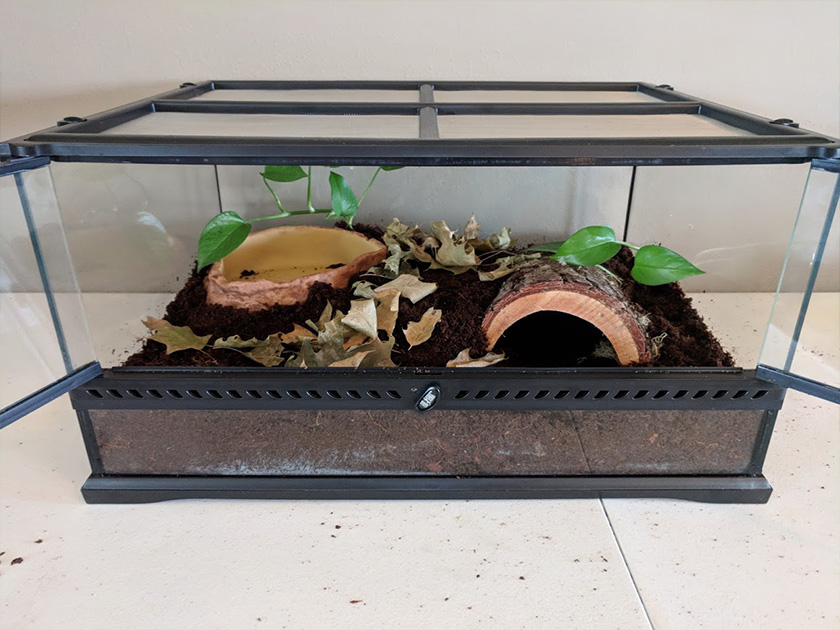
In this build, I’ve added golden pothos plants and some leaf litter. If you decide to use real plants, prepare in advance by purchasing a low powered LED grow light. Also, give the plants several weeks to establish.
Alternatively, you can leave the plants inside their containers. Just be sure to replace their potting soil and rinse the plants first. I recommend doing this to remove any unwelcomed chemicals. Because toads like to burrow, it’s important to protect the roots of live plants by leaving them in containers or placing them where your pet is least likely to burrow.
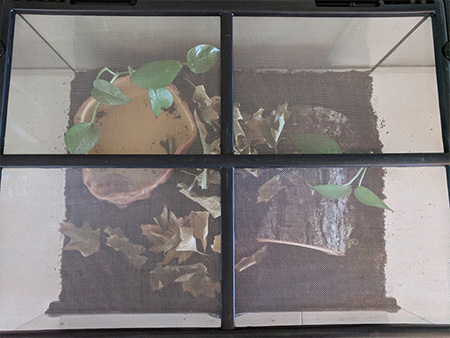
Fake plants and other decoration are great. Examine the decorations to ensure they don’t have sharp edges or anything that could be harmful. Also, don’t overdo it. Leave enough open soil for burrowing.
Leaf litter is rarely a requirement but it’s always a welcomed addition to any terrarium. Leaves create additional hiding opportunities which help your toad feel safe. Oak and Magnolia leaves are among the most popular choices due to their size and how slowly they break down.
Sphagnum moss. I recommend getting a small pack of sphagnum moss and placing it on top of the substrate in one of the corners. Sphagnum moss is great for retaining moisture. It’s also a great hiding place.
Step 7: Mist The Enclosure
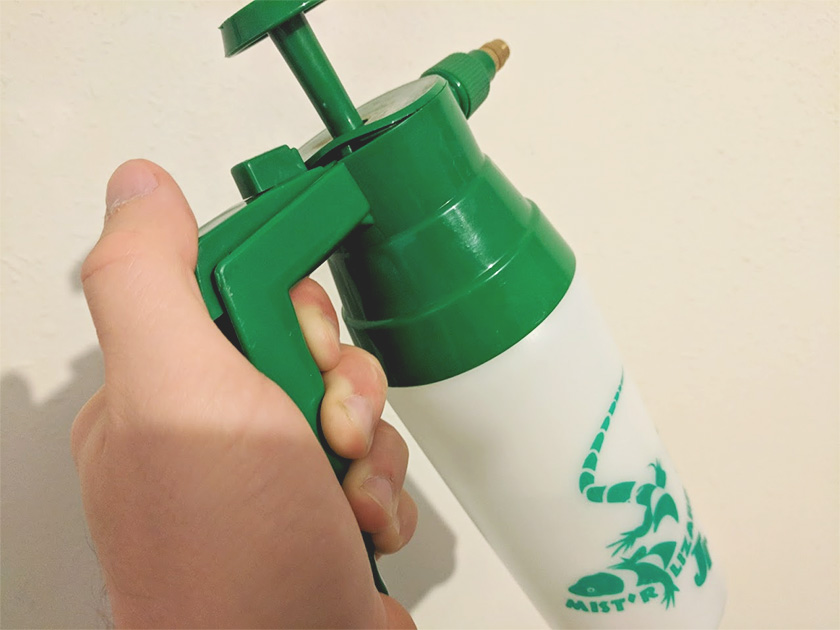
After everything is set up, give the enclosure a thorough misting. This helps the substrate to soak up some water and increases the humidity within the cage.
Introducing Your Frog to Its New Home
All that’s left now is to introduce your frog to their new enclosure. I recommend being as gentle and patient as possible. In most cases, your pet will be in a small, plastic container. Set the container inside the terrarium and remove the lid, allowing them to venture into their habitat on their own. As soon as you notice your frog is no longer in the plastic container, you can remove it from the cage.
I hope you found this guide useful! If you enjoyed it, or know someone who will, please consider sharing this post with family and friends. Thanks!

22 Comments
John,
My daughter saved a couple tadpoles from our horse trough, “raised” them through tadpolehood and one has made it to froghood. We are now trying to assemble the best terrarium possible for him, but feel like we need to know what kind of frog he is before that would be possible. Most frog sites we look at do not have pictures of baby frogs, and this little guy has already changed his appearance several times and we have not been able to narrow it down. Is there a site you are aware of that may have better pictures of little ones??
I can certainly try to help! First of all, where do you live? Knowing that will narrow down the list of frogs and toads tremendously. From that point its a matter of searching for pictures based on the common name or scientific name of the species in your area. Also, I recommend checking out iNaturalist. Search your local area for “Anura”. Anura is the family within amphibia containing all frogs and toads. You’re sure to find a bunch of pictures there! I hope this helps!
Dear John Wellington,
I really appreciate all of your excellent information on toad and frog care! It’s very helpful and encouraging. Your website rocks!
I got 3 American toad tadpoles from a neighbor’s pond mid July thinking that when they become toads I’d release them in my garden. They are toadlets now and they would become tasty treats for some critter if I released them into my garden now. I thought about setting up a huge plastic container with some kind of screen lid and fill this plastic container with substrate, put this plastic container on a pallet on my back porch in an attempt to keep them “wild” but then someone told me that the huge plastic container would be “too hot” for the toads. True “too hot?’ I had been feeding them bugs from outside not knowing I could give them parasites so now I am feeding them flightless fruit flies dusted with calcium and vitamin powders and someone told me I’m domesticating them. Am I? So now I’m thinking about keeping them as pets because of their small size and Michigan winter will be here in a couple of months. I thought about getting a 50 gallon fish tank with a screen lid for them and keeping them in my living room. You mention cleaning the tank with distilled water and adding fresh substrate. How often should I clean the tank and replace the substrate now as toadlets, then small toads and as they become adults?
Sorry if this is so long. I wish I knew what to do. Thank you for any suggestions!
Hey Denise! I apologize for not replying sooner.
1 – A plastic container is perfectly fine so long as its in a good location! If you leave it out in the sun, it’s going to get pretty warm and might cause problems for the toads! Putting it in a shaded area with a little sunlight would be better.
2 – Because American Toads are adapted to the area of the world you live in, you can feed them bugs from the surrounding area! They will be fine! Feeding them flightless fruit flies dusted with supplements is the next best thing, in my opinion. That is a healthy substitute for a large variety of wild insects!
3 – Replacing the substrate is a good idea and the frequency at which you replace it depends on your situation. The reason it needs replaced is because the toad’s droppings are acidic and this causes the pH in the substrate to become acidic over time. This can be harmful for the toads! Now, if you have 1 toad in a 50 gallon tank you won’t need to replace it very often. On the other hand, if you have 5 toads in 50 gallon tank, the substrate will get dirty pretty fast. I recommend replacing the substrate every 2 – 3 months in a 20 to 30 gallon tank with 1 – 2 frogs. I hope this helps.
I hope this answered everything! Let me know if you have any more questions! I’m glad to help!
I live you so much for this right now! Thank You! A friend of mine brought me a bucket of tadpoles from their pool (cause they know I love creatures of all sorts) I had no warning though and knew nothing about caring for tadpoles or frogs. I was instantly infatuated with them so I created some temporary habitat for them googled questions constantly (though rarely found the answers I needed when I needed them) and somehow I have managed to keep 5 super itty bitty absolutely flipping adorable little froglets alive. I have just upgraded their habitat from an aquarium to a terrarium and this whole time I’ve been scrambling to come up with things I could find around here to house them and then meet their quickly changing needs. I moved the last 2 or of the water to land today. Tonight I sat down to ask Google a few froggie questions and finally after all I’ve been through just trying to keep these poor things alive I find this page. So much good information here seriously. So my question to you is what now? I have 5 super tiny little froglets in a 10 gallon aquarium I had in storage. I plan on releasing them (or most all of them at least my heart may not be able to let all 5 go lol) but how much water do the 5 of them need in there now? They are incredibly small and I’m concerned about them surviving if I let them go till they get a bit bigger anyways. I started feeding them fruit flies cause it’s the only live thing I find small enough for them to eat. Even the real small crickets are to big for them. Is there anything else I can feed them? What kind of things should I start doing to prepare them for the world outside? I have used rain water and sifted soil from where they are from afar going back to live and have used rocks branches leaves and plants from outside to keep it as natural for them as I could. How long do I get to have them before I need to let them go lol? They are about the size of an eraser on a mechanical pencil and have just absorbed their tails fully within the last week. I know much of that was totally uneeded information I apologise. I can’t thank you enough for sharing your wisdom. I’m really glad I stumbled across it.
Hey there! Thats exciting and it sounds like you’re doing a great job! Really, you can release them at any time. I prefer to release froglets near a body of water in the evening or very early in the morning. Wingless fruit flies are about all you can easily obtain that they are big enough to eat until they’re grown enough to eat pinhead crickets!
I have an American toad and I have a 61 L tote I’m putting a divider in the middle for two different toads is there enough room? My second question is can I give my toads worms that I find in my backyard or do I need special ones. And how do I keep the worms from going into the mulch before the Toad eats?
Hello, Addy! That’s not a whole lot of room for your toads (with the divider). It could work until you get something a little bigger – or another tote. You shouldn’t feed your toads worms you find in your backyard unless your toads are native to area you’re getting the worms from! If your toads are from, say.. Asia, I wouldn’t feed them worms you found in your backyard in the US. This is because they’re not adapted to dealing with little parasites living in bugs from different areas of the world. I hope this answers your questions!
Hello dear John. You provided very useful content. Thank you. Can your design be used for a productive frog (male and female pair)?
What should be the dimensions of the terrarium? And what features should it have?
Thank you for the compliment. What type of frogs are they?
I have a couple questions? What if your toad enclosure has a smell? It’s not bad, and you can’t smell it unless you actually put your head right at the top of it. I just don’t want it to turn into an issue. We have only had the toad a few weeks now. We found him in our landscaping. He always has access to crickets, but he seems to like when we feed him mealworms better. We do have to put them on a rock or somewhere they don’t burrow themselves for him to eat them. Is that ok? He only gets a few of them every few days. He seems to be acclimated very well, as he comes out and moves around quiet often now. I am trying to make it more homey for him, and your information is very helpful.
What kind of smell? I assume what you’re smelling is the substrate and in that case, it’s normal. It’s an humid, earthy smell?
Hi! I think one of my toads may be having a problem. He/she looks like my other 2 American toads but is super tiny. The other 2 have been eating and growing but this little guy/gal might need some little toad glasses. A cricket comes near him and he tries to eat it but constantly misses. I’ve tried to hold a cricket right in front of him with a pair of tweezers but he doesn’t seem to be interested. He’s tiny and looks skinny. All three of them came from the same creek. Do you think something could be wrong with this little guy? Is there anything I can do to get him to eat? Are there toad appetite stimulants? Can a toad be force fed? I’m worried about this little guy… Any suggestions would be greatly appreciated… Thank you!
I would try putting him in his own enclosure for a while. Try feeding him small, live insects like crickets or mealworms. Mealworms might be the best option because they don’t move as fast as crickets but they still wiggle around – which is important for toads. It’s hard to say whether or not something is wrong with him. Getting him some extra food should be helpful.
I have a tadpole who is “an adult” as his tail has disappeared. He has the characteristics of a frog but I don’t know what type. He was found at a creek. How do I know when I should move him out of the aquarium into a terrarium? What should he be eating at this stage? Can frogs and toads live together?
A tadpole that absorbed its tail needs access to land unless it’s an aquatic frog. He will likely be ready to eat pinhead crickets or other small insects like fruit flies. Frogs and toads shouldn’t live together. Mixing different species almost always ends badly. They fight and each of them have different toxins that can harm each other.
In the aquarium, there are rocks that are above water level. He likes to hang out up there but he likes to be in the water with just his face sticking out. I tried putting him into a terrarium and he seemed very unhappy so I put him back into the aquarium and he seemed happier…??? How can I tell if he is an aquatic frog or a land frog? Thank you!
Can you email me a picture? Here are some of the most popular aquatic frogs.
Hey, I’m thinking about getting a pacman frog. Right now I’m trying to plan out everything I would need to set up a bioactive vivarium for one. Could I use a 12 X 12 x 12 enclosure? Or would I need an 18 X 18 x 12? and would I need a drainage layer for a pacman vivarium or can I just use the substrate?
The 12x12x12 will work for a pacman frog but if you can spare a few extra bucks I recommend the next size up. You’ll be happy with it and so will your pet. You don’t need a drainage layer so long as you get the humidity right. They like higher humidity and the substrate needs to be damp but you don’t need to overdue it. There shouldn’t be standing water.
How often do you need to replace the substrate? Thank you for an excellent tutorial!
Thanks for the nice comment, Jen! Great question too! I’ll do my best to update this tutorial with information about your question. For now, I’ll give you a quick answer here. The short answer is: it depends. It depends on your setup, how often you spot clean, and how many frogs are in the same enclosure. If you have a bioactive vivarium with springtails and isopods, you’ll never have to change the substrate. If you don’t have a bioactive setup, you’ll probably want to change the substrate out every 3 – 4 months. The less you spot clean and the more frogs you have in one enclosure the sooner you should change it out (as often as every other month). I hope this was helpful!